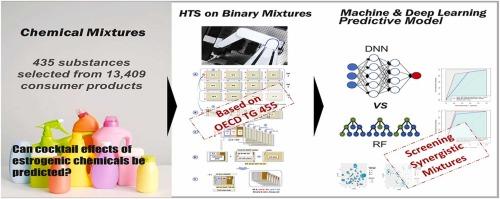基于高通量筛选数据的深度神经网络模型的开发,用于预测消费品二元混合物的协同雌激素活性
IF 11.3
1区 环境科学与生态学
Q1 ENGINEERING, ENVIRONMENTAL
引用次数: 0
摘要
化学品风险评估的范式正在不断从关注“单一物质”扩展到更全面的方法,以检查“混合物”中不同成分之间的综合毒性。“这一变化旨在解释混合物中毒理学相互作用产生的鸡尾酒效应,这可能导致风险增加。”据报道,有超过1000种潜在的内分泌干扰化学物质(EDCs),它们可以包含在不同的工业和消费化学产品中,并作为新出现的环境问题污染物释放到环境中。尽管涉及实验和预测的广泛研究已经对单个EDCs进行了调查,但对其协同效应的预测仍然相对缺乏,这一领域需要进一步调查。在这项研究中,我们广泛调查了主要在韩国销售的消费品中可能表现出雌激素活性或生殖毒性的物质。根据OECD测试指南455建立了hERαHeLa-9903细胞的高通量筛选(HTS)方法,筛选了435种物质。选择了35种(潜在的)雌激素激动剂,并考虑到物质的有效浓度和所得到的混合物的溶解度,系统地测试了它们的1,412种二元混合物,可以以四种不同的比例制备。得到了35种物质和917种混合物的最佳经验剂量-反应曲线。基于HTS数据,建立深度神经网络模型(曲线下面积(area under the curve, AUC): 0.837 ~ 0.881),并与随机森林模型(AUC: 0.656 ~ 0.829)进行比较,筛选二元混合物的协同雌激素活性。本文章由计算机程序翻译,如有差异,请以英文原文为准。

Development of a deep neural network model based on high throughput screening data for predicting synergistic estrogenic activity of binary mixtures for consumer products
A paradigm of chemical risk assessment is continuously extending from focusing on ‘single substances’ to more comprehensive approaches that examines the combined toxicity among different components in ‘mixtures.’ This change aims to account for the cocktail effect arising from the toxicological interactions in mixtures, which can lead to increased risks. More than 1,000 potential endocrine-disrupting chemicals (EDCs) have been reported, and they can be included in different industrial and consumer chemical products and released to the environment as pollutants of emerging environmental concern. Although extensive studies involving both experiments and predictions have investigated individual EDCs, predictions of their synergistic effects are still relatively lacking, an area that requires further investigation. In this study, we extensively investigated substances in consumer products, mainly marketed in South Korea, that might exhibit estrogenic activity or reproductive toxicity. A high throughput screening (HTS) assay based on OECD Test Guideline 455 for hERαHeLa-9903 cells was constructed, and 435 substances were screened using the HTS. Thirty-five (potential) estrogenic agonists were selected, and their 1,412 binary mixtures that could be prepared in four different ratios were systematically tested, considering the available effective concentrations of substances and the solubility of their resulting mixtures. The best empirical dose-response curves of 35 substances and 917 mixtures were derived in this study. Based on the HTS data, a deep neural network model was developed (area under the curve (AUC): 0.837-0.881) and compared with a random forest model (AUC: 0.656-0.829) to screen for the synergistic estrogenic activity of binary mixtures.
求助全文
通过发布文献求助,成功后即可免费获取论文全文。
去求助
来源期刊

Journal of Hazardous Materials
工程技术-工程:环境
CiteScore
25.40
自引率
5.90%
发文量
3059
审稿时长
58 days
期刊介绍:
The Journal of Hazardous Materials serves as a global platform for promoting cutting-edge research in the field of Environmental Science and Engineering. Our publication features a wide range of articles, including full-length research papers, review articles, and perspectives, with the aim of enhancing our understanding of the dangers and risks associated with various materials concerning public health and the environment. It is important to note that the term "environmental contaminants" refers specifically to substances that pose hazardous effects through contamination, while excluding those that do not have such impacts on the environment or human health. Moreover, we emphasize the distinction between wastes and hazardous materials in order to provide further clarity on the scope of the journal. We have a keen interest in exploring specific compounds and microbial agents that have adverse effects on the environment.
 求助内容:
求助内容: 应助结果提醒方式:
应助结果提醒方式:


